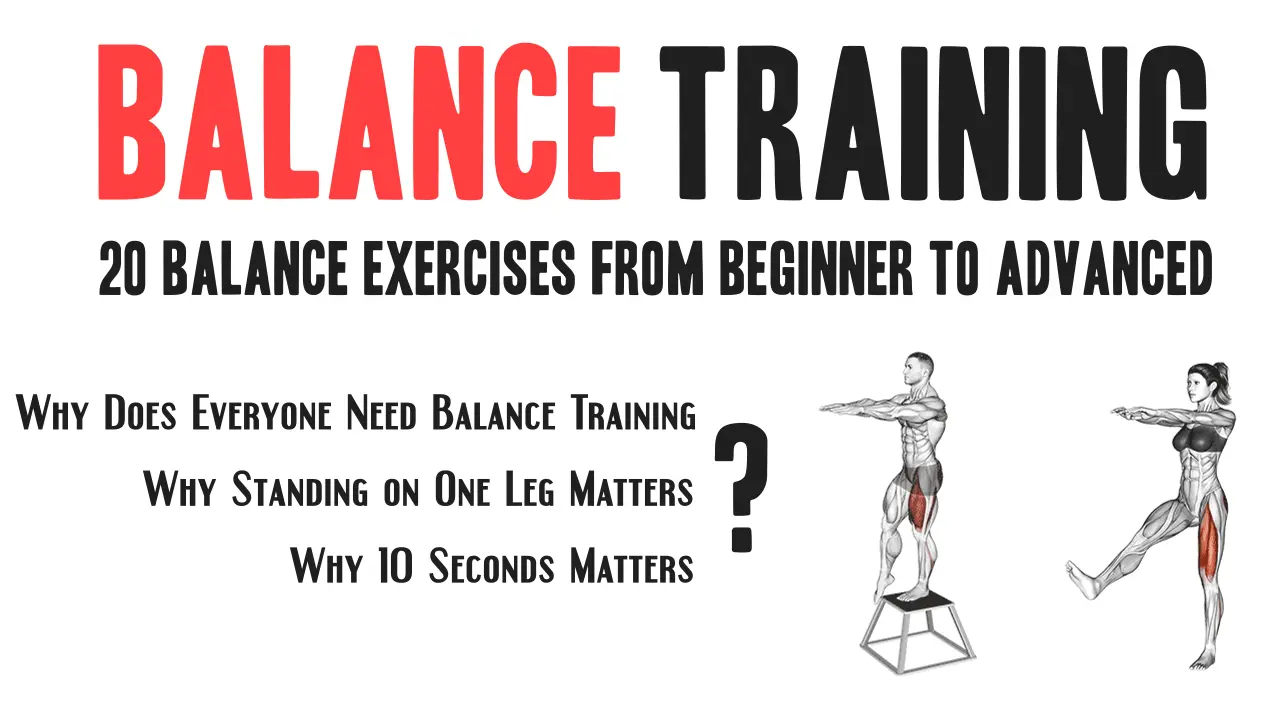Contents
- What Is Balance Training?
- The Importance of Balance: A Vital Link to Longevity
- Single Leg Stance Test (Balance Test)
- Normative Values for the Single Leg Stance Test
- Best Balance Training Exercises for Beginners
- 1. Run in Place: (2 x 10 seconds)
- 2. Standing Knee Hugs: (10 Reps for each leg)
- 3. Elbow to Knee Twist: (10 Reps for each leg)
- 4. Lateral Leg Raise: (10 Reps for each leg)
- 5. Standing Leg Circles: (10 seconds per leg)
- 6. Calf Raise: (2 x 10 reps)
- 7. Walking High Knee Lunges: (2 x 10 step)
- 8. Curtsy Squat: (2 x 10 Reps)
- 9. Lateral Step: (10 Reps per leg)
- 10. Bulgarian Squat: (10 Reps per leg)
- Advanced Exercises For Balance Training
Balance is the ability to maintain the body’s center of mass over its base of support, whether the body is stationary or in motion. It is a complex motor skill that relies on the integration of the musculoskeletal system, visual system, vestibular system, and proprioceptive feedback. It allows you to perform everyday activities—such as walking, climbing stairs, or reaching for an object—safely and efficiently. Good balance is also essential for sports performance, injury prevention, and maintaining mobility as we age.
In simple terms, balance can be divided into two main types:
- Static Balance: This refers to your ability to stay steady while your body is not moving. Examples include standing on one leg, holding a yoga pose, or maintaining an upright posture.
- Dynamic Balance: This is the ability to stay stable while your body is in motion. Activities like walking, running, changing direction, or performing sports movements rely heavily on dynamic balance.
Both static and dynamic balance are fundamental to efficient movement and physical performance. Together, they allow the body to remain stable during both controlled positions and dynamic actions, forming the foundation for safe and effective movement in daily life and sport.
What Is Balance Training?
Balance training is a form of exercise that specifically aims to improve postural control and stability. Rather than focusing solely on strength, balance training challenges the body to maintain control under varying conditions, making it a key component of functional fitness for all age groups.
Balance training exercises engage the core, legs, and ankle stabilizers while stimulating proprioceptive and neuromuscular systems. By exposing the body to controlled instability, these exercises improve movement efficiency, enhance stability, and help lower the risk of falls and movement-related injuries.
The Importance of Balance: A Vital Link to Longevity
A study published in the British Journal of Sports Medicine revealed a significant connection between balance ability and longevity. Analyzing data from approximately 1,700 individuals aged 51 to 75, researchers found that those who were unable to stand on one leg for 10 seconds had a twofold increase in the risk of premature death. Even after adjusting for factors such as age, body mass index, and underlying health conditions, participants who failed the balance test showed an 84% higher mortality risk.
As individuals age, muscle strength, coordination, reaction time, and sensory input naturally decline, all of which negatively affect balance. To preserve balance ability, it is essential to engage in regular physical activity, maintain a healthy diet, and manage body weight.
While further research is still needed, existing evidence suggests that good balance is not merely about preventing falls—it may also be a key indicator of overall health and longevity. Balance ability can serve as an important functional marker, highlighting the need for proactive balance training across the lifespan.
Single Leg Stance Test (Balance Test)
The Single Leg Stance Test is a widely used clinical assessment tool employed by healthcare professionals, including physical therapists and physicians, to evaluate balance and postural stability. It is commonly used to identify fall risk and to guide the development of targeted balance interventions.
How to Perform the Test
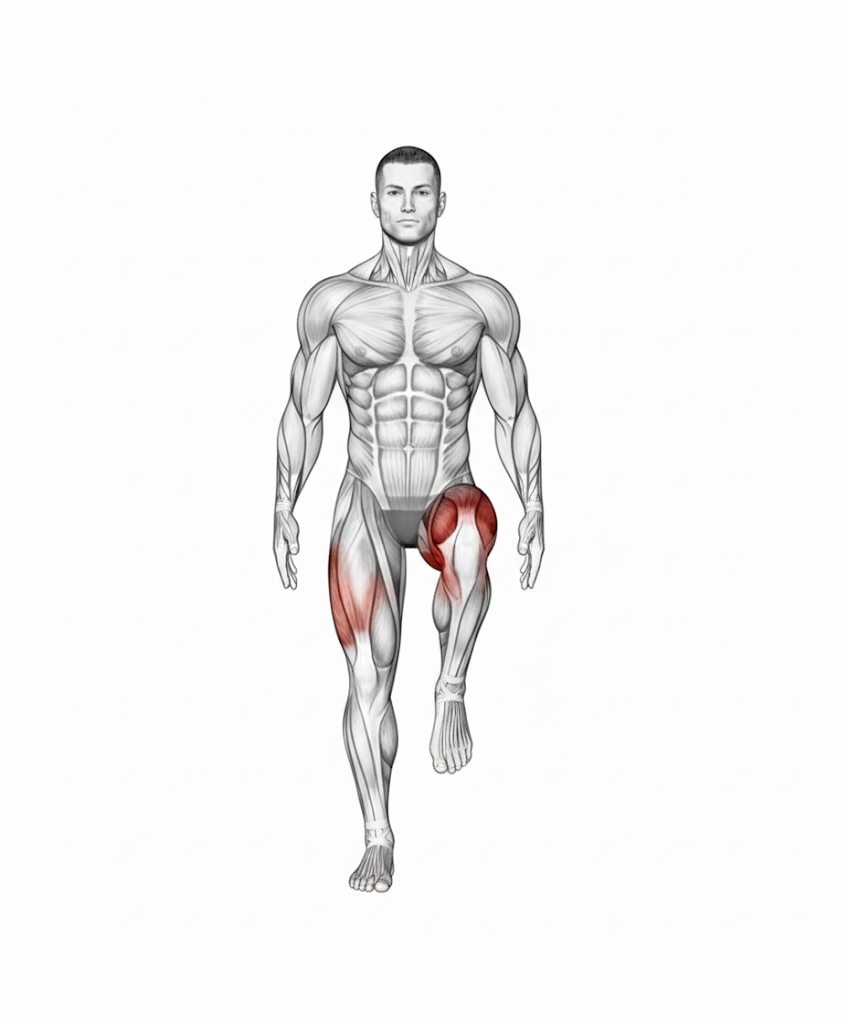
- Stand barefoot on a flat surface.
- Lift one foot off the ground and balance on the opposite leg.
- Keep your eyes open and focus on a fixed point in front of you.
- Measure how long you can maintain balance without touching the raised foot to the ground or losing stability.
- Repeat the test on the opposite leg.
- Record the time for each leg.
Longer durations generally indicate better balance performance.
Normative Values for the Single Leg Stance Test
| Age Range | Eyes Open | Eyes Closed |
|---|---|---|
| 18–39 | 43 seconds | 9 seconds |
| 40–49 | 40 seconds | 7 seconds |
| 50–59 | 37 seconds | 4.8 seconds |
| 60–69 | 26.9 seconds | 2.8 seconds |
| 70–79 | 18.3 seconds | 2 seconds |
| 80–99 | 5.6 seconds | 1 second |
These scores represent the average durations individuals in each age group should be able to maintain balance during the Single Leg Stance Test with eyes open and closed (1). They serve as benchmarks for assessing balance and stability, with longer times generally indicating better performance. However, individual results may vary based on factors such as fitness level, health conditions, and previous injuries.
Best Balance Training Exercises for Beginners
Incorporating these balance training exercises into your routine can lead to overall improvements in strength, stability, coordination, and functional fitness. As with any exercise program, it’s essential to perform them with proper form and gradually progress the intensity to avoid injury and maximize benefits.
1. Run in Place: (2 x 10 seconds)
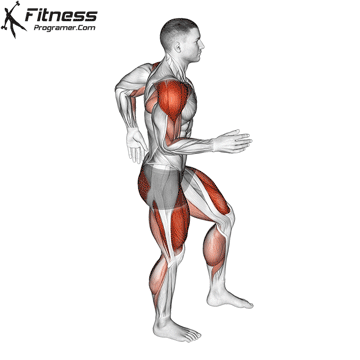
Targets: Leg muscles (quadriceps, hamstrings, calves)
Benefits: This basic exercise serves as an excellent introduction to balance training, facilitating the transition between feet. Moreover, its dynamic structure increases heart rate and calorie consumption, improves cardiovascular fitness and increases leg strength and endurance.
How to: Lift your knees high while staying in one spot, mimicking the motion of running. Focus on maintaining good posture and engaging your core for balance.
2. Standing Knee Hugs: (10 Reps for each leg)
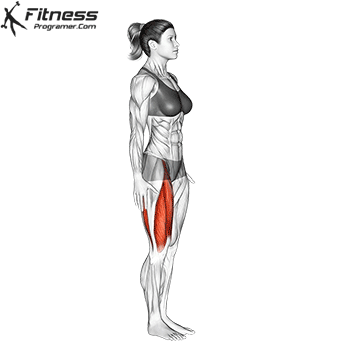
Targets: Hip flexors, iliopsoas, rectus femoris, sartorius and hamstring
Benefits: By lifting one knee at a time while standing on the opposite leg, standing knee hugs challenge your balance and stability, helping to strengthen the muscles involved in maintaining an upright posture.
How to: Stand tall with your feet hip-width apart. Lift your right knee toward your chest using both hands to pull it in gently. Hold the position for a few seconds, feeling a stretch in your hip flexors and lower back. Release your right leg and repeat the movement with your left knee.
3. Elbow to Knee Twist: (10 Reps for each leg)
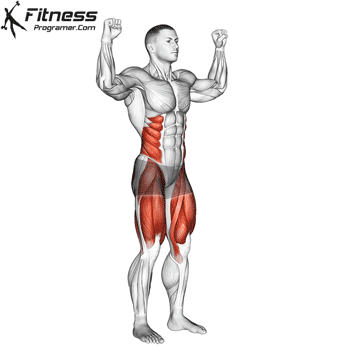
Targets: Leg, core muscles, obliques
Benefits: Improves core strength and stability, enhances rotational mobility in the spine, challenges balance and coordination.
How to: Stand with your feet hip-width apart and your hands bent next to your head. Lift your right knee towards your chest while twisting your torso to bring your left elbow towards your right knee. Return to the starting position and repeat on the other side.
4. Lateral Leg Raise: (10 Reps for each leg)

Targets: Gluteus medius and minimus, tensor fasciae latae, hip stabilizers
Benefits: Performing lateral leg raises requires core engagement and balance to keep the body stable while lifting the leg to the side, making it an effective exercise for improving balance and coordination.
How to: Stand tall with feet hip-width apart. Lift opposite leg out to the side, maintaining control. Slowly lower leg back down. Repeat for desired reps, then switch sides.
If you find it challenging to balance on one leg, you can perform the exercise near a wall or sturdy object and lightly touch it for support as needed.
5. Standing Leg Circles: (10 seconds per leg)
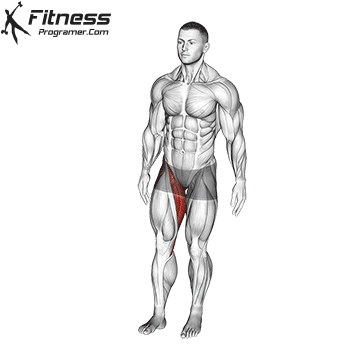
Targets: Hip abductors, glutes, quadriceps, core stabilizers
Benefits: Enhances hip stability and mobility, strengthens leg muscles, improves balance and proprioception.
How to: Stand tall, lift one leg off the ground, and make circles with that leg, controlling the movement and maintaining balance. Switch legs and repeat.
You can do the exercise next to a chair or wall and gently touch it for support when needed.
6. Calf Raise: (2 x 10 reps)
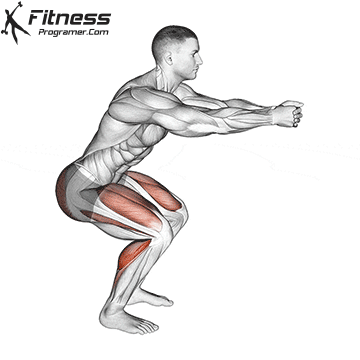
Targets: Soleus and gastrocnemius muscles (calf muscles)
Benefits: Strengthens the calf muscles, improving lower leg stability and balance. Helps to improve posture and overall lower body alignment. Can be performed anywhere with little to no equipment, making it a convenient exercise for building balance and strength.
How to: Begin in a squat position with feet shoulder-width apart. Lift your heels off the ground by pushing through the balls of your feet. Hold at the top for a moment, then lower heels back down.
7. Walking High Knee Lunges: (2 x 10 step)
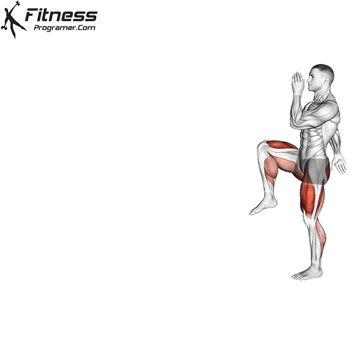
Targets: Quadriceps, glutes, hamstrings, core muscles
Benefits: Beneficial for your balance training, this exercise strengthens lower body muscles, improves balance and coordination, increases hip flexibility, improves cardiovascular fitness.
How to: Perform a lunge while bringing your opposite knee towards your chest with each step. This exercise challenges balance, coordination, and strength.
8. Curtsy Squat: (2 x 10 Reps)
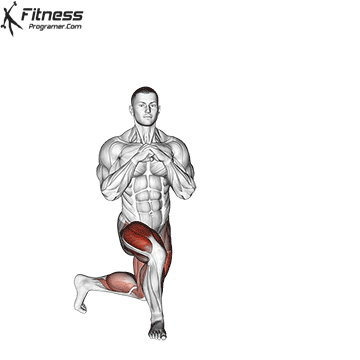
Targets: Glutes, quadriceps, hamstrings, adductors
Benefits: Builds strength and muscle tone in the lower body, improves hip mobility and stability, challenges balance and coordination.
How to: Stand with feet hip-width apart, then step one foot diagonally behind the other, lowering into a squat. Return to the starting position and repeat on the other side.
9. Lateral Step: (10 Reps per leg)
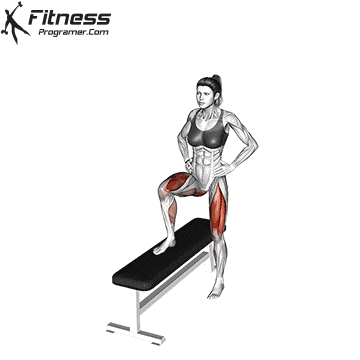
Targets: Quadriceps, glutes, hamstrings, calf muscles, stabilizing muscles
Benefits: Builds strength in the lower body, particularly in the lateral muscles, improves balance and stability, enhances functional movement patterns.
How to: Using a step or platform, step laterally onto the platform with one foot, then bring the other foot to meet it. Step back down and repeat on the other side.
10. Bulgarian Squat: (10 Reps per leg)
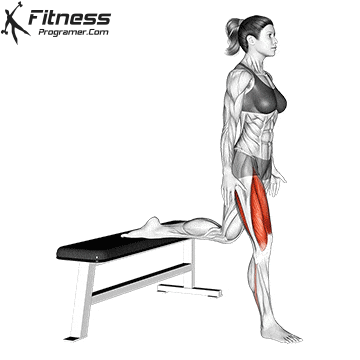
Targets: Quadriceps, glutes, hamstrings, calf muscles, stabilizing muscles
Benefits: Highly effective for your balance training, this unilateral exercise improves balance and stability by strengthening the legs individually, increases flexibility in the hip flexors, and challenges the core muscles.
How to: Stand facing away from a bench or elevated surface, with one foot resting on it behind you. Lower into a squat position with the front leg while keeping the back leg elevated. Return to the starting position and repeat.
Note: Balance training involves working not only the lower body muscles but also the upper body muscles and strengthening the core muscles. Here’s a step-by-step guide to building a strong core.
Advanced Exercises For Balance Training
These advanced exercises require significant strength, coordination, and balance to perform correctly and safely. They can be effective for improving athletic performance, enhancing overall stability, and challenging your fitness level. Ensure proper form and start with lighter resistance or modifications if needed before progressing to more challenging variations.
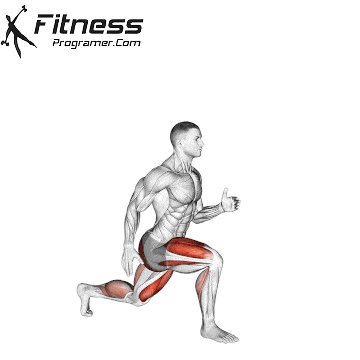 Power Lunge | 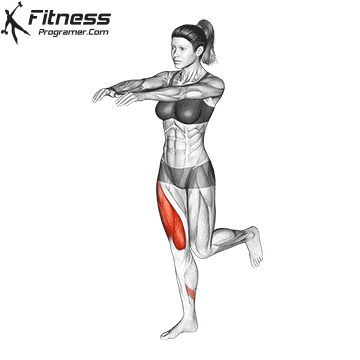 Skater Lunge |
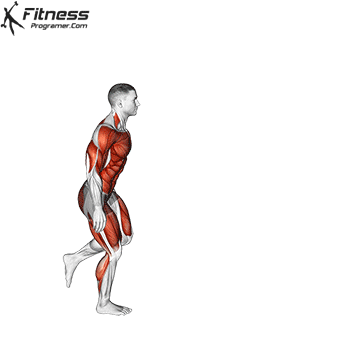 Single Leg Broad Jump | 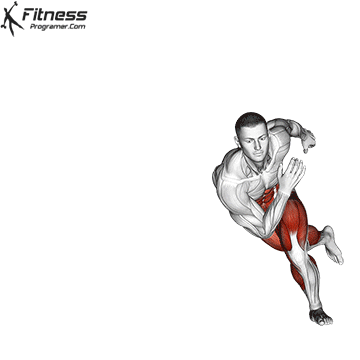 Skater |
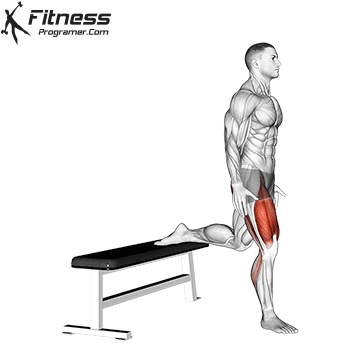 Bulgarian Split Squat Jump | 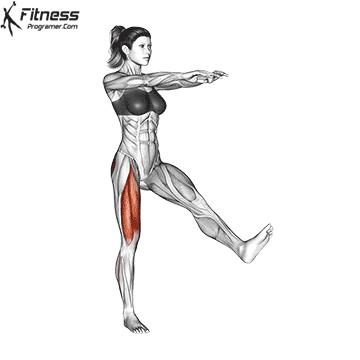 Pistol Squat |
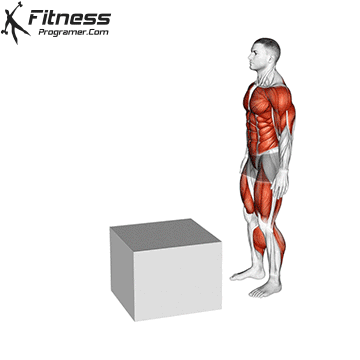 Box Jump 2 to1 | 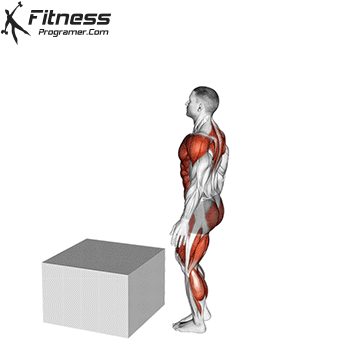 Single Leg Box Jump |
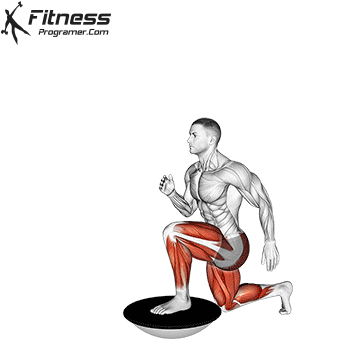 High Knee Lunge On Bosu Ball | 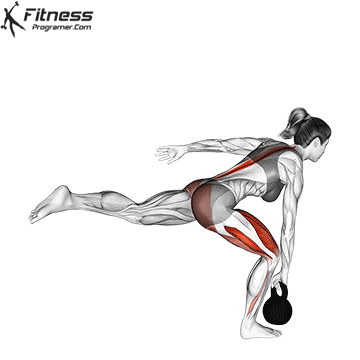 Single Leg deadlift |
Conclusion
It’s important to start balance training gradually, especially if you’re new to it or have any existing health concerns. Progressively increase the difficulty and intensity of exercises as your balance improves. Additionally, always prioritize safety by using proper form, wearing appropriate footwear, and having a stable surface nearby for support if needed. If you have specific health concerns or conditions, consult with a healthcare professional or certified trainer before starting any new exercise program, including balance training.

